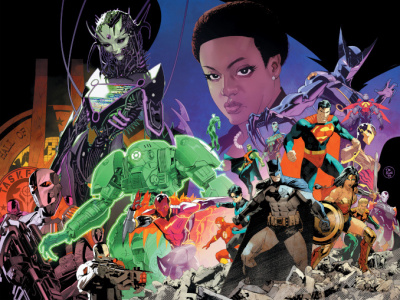
DC recently announced Minx, a new graphic novel imprint for titles that appeal to a teen female reader, in an article in the New York Times (see 'DC Announces Minx Line'). We spoke to Karen Berger, Senior Vice President of DC Comics, about the new initiative, the audience it seeks to reach, and how it fits into the current context of comics for teen girls, which are primarily manga.
The first question is about the opening quote in The New York Times article, which was, 'It's time we got teenage girls reading comics.' Were you talking about DC comics? Because there are a lot of teenage girls reading comics.
Yes, exactly. It's reading DC Comics. Teenage girls do read manga, obviously, and I made a big point of that when I was being interviewed--that the influence of manga in terms of getting teenage girls to read comics in general is amazing and wonderful--and I don't think that came across that fully in the New York Times piece. Of course, teenage girls are reading comics, they're reading manga. What that quote really means is that the point for us is that it's time for teenage girls to be reading DC comics and also to be reading comics that are published by an American publisher because there's nobody in the States who is doing anything in full force. Scholastic has done a number of books for teenage girls, and small press and self-publishers have, but in terms of the major imprints, there's no American publisher doing it, and that was really my point.
I guess it depends on how you classify Tokyopop, which is doing some stuff directed at that audience.
In terms of original manga?
They're doing some.
Yes, they're doing some. I think that falls in with the manga mold....
That raises the question, do you feel like the style of the work for Minx, and I know it's somewhat disparate, will be more akin to American comics or to manga?
It's more akin to American comics. We're not using the manga role-model in terms of visual pacing and in terms of the kind of layout. We're doing a more straight-forward American grid style, four-to-six panels per page kind of thing.
As you were saying, there is a range--the majority of them are not manga influenced, but there are some that are. Sonny Liew, who's doing Re-Gifters, is an American Korean artist whose art style has manga influences, but his panel layout is more American.
How is this organized at DC? The Times article refers to Shelly Bond as 'a Minx editor.' Is there more than one Minx editor?
No, she's 'the' Minx editor (laughs). Shelly's a group editor at DC Comics. She's been a group editor at Vertigo for a number of years, and she has worked with me on Sandman for many years. She came up with the idea for doing these a few years ago as an alternative to manga, as an alternative to young adult fiction for teenage girls, and really wanted to carve out an area in American comics for our company. Shelly reports to me directly and I am working with Shelly in reviewing proposals and kibitzing here and there and helping to guide the line, but she is the main editor of the line.
What is the target age of the Minx line?
13 to 18.
How would you differentiate between the Vertigo and Minx audiences?
They're very different. The Vertigo books are aimed at an older reader, 18 and up. It's still predominantly men, but we have a lot more women reading Vertigo titles. Sandman did a huge thing for us there, Neil's work in general, Y, The Last Man, Fables. Many Vertigo books have a high female readership; but it's still a unisex read, shall we say, where Minx is specifically targeted for the young adult female teenager. It skews younger than the Vertigo material and it is for a girl; it's not for a guy.
So you've viewed Vertigo historically as...
Vertigo as being genre fiction, whereas creatively, Minx is essentially real stories about real girls in the real world.
So that's another difference from manga, which often has some fantastic element associated with a teen/high school kind of story.
Exactly. I'm not saying at some point we might not do that, but for now that's our take. One of our stories later on in the year has a futuristic angle to it and a kind of cyber angle too, but it's still a real world-based story, a real world based in the future (laughs). It's about the first digital girl, but it's not like people with powers or supernatural assets or...
My teacher is an alien kind of stuff...
Exactly.
Talk about the decision to go straight to graphic novel as opposed to starting with floppies. We assume that's related to the target audience and where they shop and how they buy?
Absolutely. You know manga is predominantly bought in a bookstore by teenage girls. Minx is directly targeted at that girl who is already buying manga or who has been introduced to graphic novels through books like
We've talked a bit about the fact that teenage girls have been buying their graphic novels predominantly, although not exclusively, in book stores. With a publisher that has the direct market clout of DC now involved in producing a line specifically for teen girls, do you expect, or hope, or are you striving to pull the comic store audience a little more female as well?
That would obviously be wonderful. Getting more girls into comic shops has been a goal of many of ours for years. I think on some Vertigo titles we've been able to achieve that. Yes, of course we hope girls will seek out comic shops as well.
Was Sandman the top female percentage, in terms of the demographics of your readers, of your Vertigo titles?
Yes, definitely.
What kind of percentage is that?
We don't have hard numbers. Just talking to Neil and his summation in terms of people that correspond with him, in terms of his own Web site, in terms of signings that he's done, in terms of conventions and who makes up the panel room audience when we have Sandman-related stuff, I think we're pretty close to a 50-50 audience on Sandman.
Tell us a little bit about the schedule. How many Minx releases will there be in 2007?
There'll be seven. We're launching with P.L.A.I.N. Janes in May, and we're releasing one a month.
Are any of them series?
Two of them we're planning second volumes; the majority are stand-alone.
Which ones are those?
We haven't announced them yet.
How many books are you putting out in 2008?
We haven't finalized that, but probably at least the same number as we're putting out in 2007. I'd say seven to 10, as a rough guess
Anything else you want to communicate to the trade on Minx?
We have a great batch of writers and artists telling stories for a market that can only grow for us in comics. Again, thanks to manga, teenage girls have been introduced to our form. We're hoping with Minx that we'll be providing yet another place for teenage girls to read compelling stories.
One unrelated question--how is Pride of Baghdad doing? It got a lot of press attention.
It got phenomenal press attention; it's done really well for us. We went back to press on it. We don't like to reveal print runs here, so I can't tell you how many we've sold, but we've done really, really well. In terms of our original graphic novels that Vertigo has done, outside of Sandman Endless Nights, it's been our best selling Vertigo original graphic novel.







